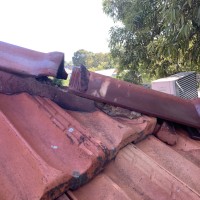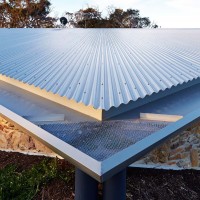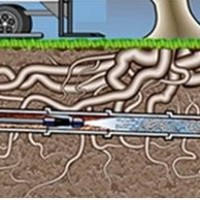FAQ/BLOG

Safety Starts with You
A Roof is obviously an unsafe place to work.
We often hear "We never needed it before, so why spend money now on a safety system?"
Thankfully, times have changed! We never used seatbelts or bought cars with 5 Star Safety ratings either! We no longer simply accept that Death or Injury is just a part of roofing work. Today, the Work Health & Safety Regulations set out safety principles and penalizes those who don't comply with the Law.
Approx. 85% of roofs in NSW are non-compliant with current WHS legislation. This means that it’s not possible for tradespeople to carry out work on a roof in a completely safe manner. At present we do our best to keep our workers safe by setting up temporary anchor points where possible as we carry out roof and gutter installations and do repairs.
The installation of a permanent Safe Roof Access System (Anchor points, ladder brackets, ladders etc.) ensures that from the moment a tradesman leaves the ground and starts climbing the ladder, until the moment he steps off the ladder at the completion of the work he is safer from falling and injuring himself.
We install Anchor Points on residential, commercial and strata managed properties. Our anchors are specially designed to absorb energy, reducing the risk of personal injury and damage to your property. Our anchor points provide 360-degree access, reducing the number of anchors needed to make a roof safe and are rated to withstand 15kN. (AS/NZS1891.4 standard)
Certification and Annual Re-Certification
Our Safe Roof Access Systems are supplied with a Certificate of Compliance and a full Diagram Plan showing the position of each individual component.
We have a free reminder service to remind you when your Safety System is due for re-certification. We are also fully qualified to re-certify existing systems.
While the initial outlay may be substantial, it is an investment in the property from a servicing & WHS compliance point of view.
You may not at present be able to install a full Safety System due to budget constraints. Why not consider installing one or more anchor points to improve safety? You could do this at regular intervals until your property is fully WHS compliant.
Why use our Safety Service?
Some companies install safety systems - that's all they do. We as roofing specialists, actually do work on roofs, so the position or placement of safety components is no academic exercise for us. We understand how they will be used! We install safety systems that are not only Compliant, but practical and safe for tradespeople to use.
NB: To see your legal obligation to provide a safe work environment – click here for applicable extracts of the law:
Pointing & Bedding - What it is, How it affects a Tiled Roof
Looking up at your roof you can see a cement looking product that is applied around the hip & ridge caps. That cement is called Pointing. What you can't see is that under the Pointing is the 'Bedding'. Bedding is a cement mix that binds the ridge and hip cap tiles to the roof, and the Pointing fills in the gaps as it were, providing a strong, watertight finish to your tile roof and ensures tiles don't get blown off in strong winds!
For many years, the traditional way to re-point the tiles were with four parts sand and one part cement. However, this is not flexible and tends to crack and crumble over time compromising the strength and waterproofing of your roof. Today, we do things differently. We use the latest in flexible tile pointing products which are available in a large range of colours to match your roof tiles. The flexible pointing is applied on either side of the ridge capping tiles and on the joins, and can cope with small movements of the tile ridge capping much better than old sand and cement.Re-pointing also seals the cracks in the bedding between the ridge caps and the roof tiles. This is the waterproof membrane for the ridge caps.So, if your old roof has a leak and the leak is caused by water entry through the ridge capping, then re-doing it with flexible pointing will do wonders to stop the leaks!
Be warned though, pointing is an expensive repair as its skilled labour intensive. If you have been given a pointing price way below other quotes, then you may have a quote from what we call 'the skim coat brigade'. These 'roofers' simply apply the thinnest skim coat film over the existing pointing without proper preparation. It takes time to carefully chip out loose pointing, wire brush the caps or even use a grinder to ensure a good clean surface for long lasting adhesion. The 'skim coat brigade' save time and lots of pointing mix by smearing a film over the top. It won't last long, and you will be back to a leaky roof and paying for repairs again. See examples below: Examples of 'Skim Coat Pointing' where a thin film is smeared over the existing pointing without proper preparation.
If your roof leaks, or you can see loose bits of cement lying on your roof tiles and in the gutters - you need to act quick and get repairs done.
Our Pointing & Bedding service also includes:
Replacing broken or cracked tiles
Sourcing tiles to match if you don't have spares.
Roof or Gutter repairs if required
Pointing Gable ends
Itemised roof and gutter condition report upon completion
.jpg)
.jpg)
Examples of 'Skim Coat Pointing' were a thin film is smeared over the existing pointing without proper preparation.


COLORBOND - Product Review
Did we say we provide unbaised views? We love COLORBOND!
Why?
As roof specialists in Sydney, our experience is that choosing COLORBOND is no contest.
The Australian environment and weather is not forgiving, especially during ‘El Nino’ events. In Sydney we experience long dry spells punctured (Forgive the pun...) by brief but intense storm events with hail, strong winds and a deluge of water testing our roofs to the limit!
Our properties are also often surrounded by gum trees – and in wind and storms, branches break off and damage our roofs, and sometimes, even more. Gum trees are called 'Widowmakers' for that reason.
As experienced roofers, we find that we are booked out for months after just one such event. However, we note that tile roofs are the most affected with numerous tiles broken and pointing damaged easily by a falling branch. Most tiles are pretty hard to come by as many are not made anymore. We often have to search demolition and recycling yards for tiles to fit the roof. Can you see the problem? Time is money, and while we are looking for tiles your roof is either patched or open to the elements. COLORBOND roofs are much more forgiving, taking hail and most branches in their stride. If a roof sheet is damaged, its easily and quickly replaced for little expense.
Architects love COLORBOND for its flexibility and stunning looks in building design.
COLORBOND steel is a great, low maintenance Australian product. Many customers ask for their old tile roofs to be replaced with long-lasting COLORBOND, and this can be done with surprisingly little disruption.
With new COLORBOND flashings and fascia boards, and a wide range of contemporary colours, COLORBOND will modernize any roof and last for decades!
Ask us about the new COLORBOND Matt range!
Storm Water Pipes - How Important?
We tend to give greater attention to the maintenance items we can see…and therefore the storm water drainage system from our property is often neglected.
In Sydney, many properties have regular maintenance such as gutter cleaning, roof checks, replacing broken tiles, and doing roof repairs, etc. However, if debris, tree roots or anything else is entering the storm water pipes and is reducing or blocking water flow, problems start.
Even with the best, cleanest gutters and down pipe system, in a storm event when we want our gutters and downpipes to drain the water away, the water will be restricted at the storm water pipes. Water will back up the downpipe, gutters will overflow into the roof space and cause costly damage inside.
Storm water repairs can be costly, especially if we must dig up and replace pipes. This often involves digging up gardens, council footpaths or driveways. We often need council approvals, even road closures/traffic control, so you can see why it’s expensive.
What to do?
Firstly, have a Stormwater Inspection done:
A Fixed Rate Service is best so that there are no expensive surprises! The service should include: Inspection of Storm water pipe, clearance of blockages if possible and an inspection report. We recommend a fixed rate that covers 1 hour of labour identifying and clearing blockages using a professional CCTV Camera, a Sonde locator and a high grade jetter. We first look with our CCTV camera. From our camera we can see if the pipe is collapsed, has debris, tree roots, etc. If we see blockages, we insert the high grade jetter to see how quickly the blockage can be removed. If a blockage cannot be resolved in the hour (i.e. Collapsed pipe) a free quote will be provided to repair the pipe, or to keep on jetting.
An Inspection allows you peace of mind to know the current condition of the storm water pipes & drains and determine if regular maintenance or repair works are necessary.
This service alleviates potential flooding to your property giving you peace of mind and confidence in wet weather & storm conditions.
Our technicians are highly trained in all facets of plumbing including domestic, commercial & civil works.

